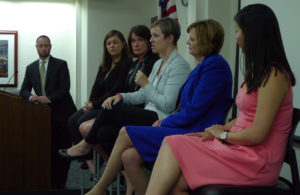After a nail-biter of a spell spent teetering on the brink, Michigan’s economy is well into recovery. Unemployment is low and job growth is steady. Talk to Michigan’s employers, however, and it’s plain there is still work to be done, on its workforce.
The state of the state’s employee pool is “in crisis,” said Jen Nelson, vice president of public policy and economic development for Business Leaders for Michigan, during a recent panel discussion on workforce development held at the state Chamber of Commerce offices in Lansing.
The panel discussion, part of a series co-sponsored by the Citizens Research Council of Michigan, MIRS and the Michigan Chamber of Commerce Foundation, presented five experts on the challenges of training, recruiting and otherwise preparing candidates for the challenges of today’s workplace. Besides, Nelson, they included:
- Brandy Johnson, executive director of the Michigan College Access Network
- Irene LeCrone, coordinator at Jackson County Cradle 2 Career Network
- Susan Porrett, executive campus director of Davenport University’s Lansing campus
- Ashley Kryscynski, coordinator of the Washtenaw Futures College Access Network
The five agreed with Nelson that for the state’s workforce to meet the needs of employers, today and in the future, it will need more. “Of everything,” said Johnson, whose organization supports students as they seek not only college, but any post-secondary job training leading to well-paying employment.

Bob Thomas, director of the Michigan Chamber of Commerce Foundation led the panel discussion with, L-R, Brandy Johnson, executive director of the Michigan College Access Network; Irene LeCrone, coordinator at Jackson County Cradle 2 Career Network; Jen Nelson, vice president of public policy and economic development for Business Leaders for Michigan; Susan Porrett, executive director of Davenport University’s Lansing campus; and Ashley Kryscynski, coordinator of the Washtenaw Futures College Access Network.
With a goal of 60 percent of Michigan high-school graduates completing post-secondary education or training by 2026, Johnson said her group emphasizes to students that stopping after they’ve earned a high-school diploma is a “pathway to poverty.” Increasing the overall level of educational attainment is the fastest way to build wealth in Michigan.
“College is a public good,” Johnson said. “It should not be considered anything else.”
But the barriers to growing credentialed workers in Michigan are many. One-size-fits-all secondary education leaves too many students unaware of alternatives, not only to traditional high school, but training afterward. So-called “soft skills” – showing up on time, proper dress and conduct in the workplace – are lacking. And money is a problem at many levels.
“We cannot solve the problems with education in our community until we address the issues of poverty,” said LeCrone, who said Jackson employers have openings they cannot fill, in part because of complications related to a low-income worker pool – transportation, child care, etc.
Remaking, or at least reforming, high school is important, at least for some students. Kryscynski said many can benefit from alternatives to the traditional four-year experience, including middle college, internships and other chances to blend higher education and work experience, “anything to help students wrap their minds around post-high school life,” Kryscynski said.
Porrett, from Davenport, said that school’s most reliable strategy takes different approaches for different student populations, including a wide range of two-year and four-year options, internships, and support for all. Students are assigned a single counselor/advisor when they enroll, and that individual only grows more aware of the talents and needs of each as they move through various programs.
Several panelists mentioned the importance of partnerships as well, with employers and agencies like Michigan Works, so that students get multiple opportunities to visit workplaces and talk to employers and employees about what they do.
Nelson, from BLM, said the state also needs to address out-migration of its most educated and skilled workers, as other states and industries seek to lure them away. Making the state attractive to younger workers will pay off, especially with industries like mobility and its vast growth potential.
“I think we can turn this,” said Nelson. With many of the state’s cities thriving, “we’re starting to see some immigrants from Chicago.”
